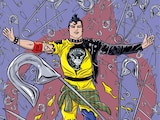My first intro to Harley Quinn and Poison Ivy came when I was just a kid thanks to Batman: The Animated Series. Their relationship was one of my favorite parts of the show and I always hoped that Ivy would finally help Harley see a way out of her abusive romance with the Joker. It never happened there, but now that it has in the comics, Harley and Ivy is a pairing I thoroughly enjoy.
In Jody Houser and Adriana Melo’s Harley Quinn and Poison Ivy, we meet an upbeat Harley who seeks to help her “Pammie” recover from a mysterious resurrection and, in the process, turn over a new leaf—no pun intended.
A brief bit of background for anyone who might not know. Poison Ivy was one of several heroes and villains killed in a massacre at the rehab facility known as Sanctuary in DC’s earlier event series, Heroes in Crisis. In that comic, Harley Quinn and Booster Gold, who both survive but can’t remember the killings, are pinned as suspects and must prove their innocence. You don’t have to have read Heroes in Crisis to enjoy Harley Quinn and Poison Ivy, but you do need to know that Ivy is killed, then revived using a rose she once gave to Harley and her connection to plants via the Green.

The plot revolves around that resurrection, which proves to be both incomplete and unstable. Harley commits herself fully to finding a cure, and the two embark on what is at times a lighthearted and zany road trip. Harley narrates most of the adventure, so you can expect a lot of quirky Harley quips, both in her head and said aloud. My favorite among them is when she tells a villain who tries to unload on her that she usually charges for therapy. You know, sometimes I forget Harley started out as an Arkham psychologist.
Though the road trip is fun, it’s not without drama. Throughout it all, the pair are chased by the Floronic Man, who tracks Ivy from place to place, unleashing plant-based hurdles at the pair. While Harley was framed for the Heroes in Crisis tragedy, here Ivy faces off against a nemesis who fights her with similar tricks.
Those flashy fights and the mysteries surrounding Ivy’s enemy and resurrection aside, what really shines here are the personal arcs and relationships.

Thanks to the events of Heroes in Crisis, Harley’s had some space to reassess who and what she is. She tries to convince herself she’s a good bad guy or, she considers, a terrible one, whichever means she’s better at it. But when push comes to shove, Harley feels like she might not really be a villain at all. She was accused of committing a mass murder, but that’s not really a Harley thing. What if, Harley thinks, it’s time to switch sides and be a superhero? She plants her feet on the redemption path, and there’s a lot of comedy in the way her newfound resolve butts against her attitude. Sure, she wants to be a good person. But sometimes that still involves whacking people and plant monsters with a giant mallet.
In many ways, I adore Harley’s personal redemption arc. As I said, my introduction to her really began as a small child. Back then, she never seemed like a die-hard villain to me. She rarely delights in violence the way the Joker does and within her is a kind heart and soul. She loves people, she loves animals, and she’s learning to love herself. She doesn’t lack empathy. In fact, she might have a little too much for her own good. Harley as antihero or superhero is a turn I’d gladly enjoy, especially given her personality.
It’s hard to talk about what happens between Harley and Ivy without spoiling a few twists, but it’s all surprisingly touching. Whenever one is threatened, the other becomes fiercely protective. When Ivy’s deteriorating in a mall shopping bag thanks to her unreliable form, Harley’s hand reaches over to gather her withered fingers. In any form, Harley loves her, and that proves to be the linchpin of the whole thing.

If there’s one more thing I can say about this series, it’s that it’s gorgeous. Our heroines are brought to life beautifully by Melo. In those moments where emotion is important, there’s a real depth of feeling on their faces. The plants they fight are also really fun, modifying to fit each leg of the pair’s journey.
Harley Quinn and Poison Ivy is a fun read that still packs its punches, and fans of the duo—especially Harley—should find it refreshing. You might even laugh a little. Or cry. Really, it’s all there without ever veering too dark.
Harley Quinn and Poison Ivy by Jody Houser and Adriana Melo is now available at bookstores, comic shops, online retailers and also as a digital graphic novel.
Juliet Bennett Rylah writes about horror comics and the dark side of superheroes for DCComics.com. Check out more of her writing on WeLikeLA, No Proscenium and IGN, and be sure to follow her on Twitter at @JBRylah.















